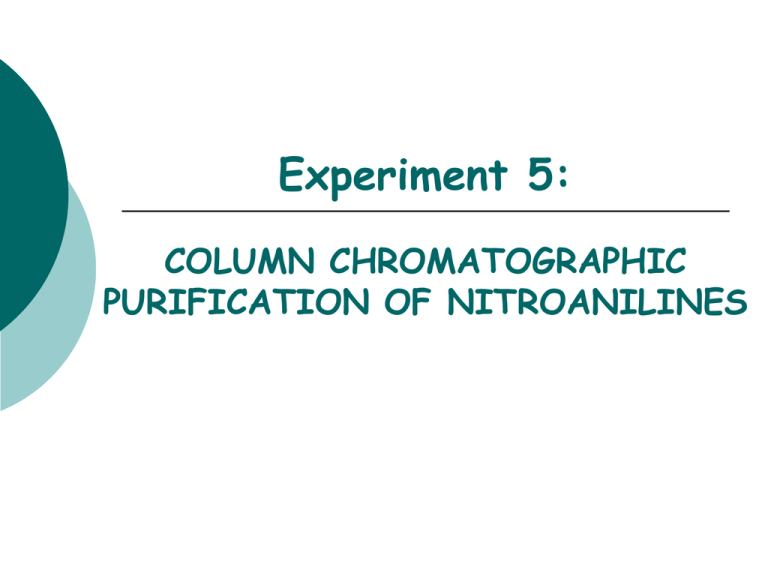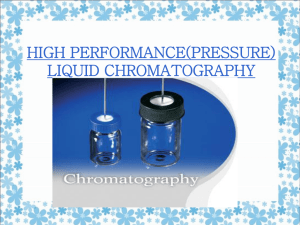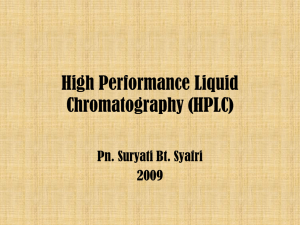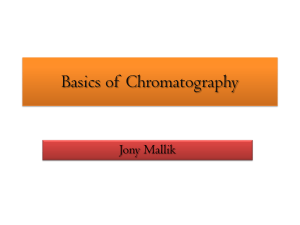Experiment 6:
advertisement

Experiment 5: COLUMN CHROMATOGRAPHIC PURIFICATION OF NITROANILINES Objectives To learn the separation technique of column chromatography. To separate constitutional isomers of o-nitroaniline from p-nitroaniline using this technique. To analyze the purity of the isolated compounds using TLC and HPLC. Before coming to lab… Prepare the Pre-lab notebook entry for this experiment! It is *highly recommended* that you watch a short video prior to coming to lab! Simply copy and paste the following link into your address bar: http://www.youtube.com/watch?v=EytuRMS1154&feature=related Please note that this is an example of how column chromatography experiments are performed, however our procedure may be slightly different. TLC VS. COLUMN CHROMATOGRAPHY Polar components (b) adsorb more strongly to the polar silica gel and elute after the less polar components, which move more quickly with the non-polar (relative to silica gel) solvent. COMPARISON OF LIQUID CHROMATOGRAPHY METHODS TLC HPLC Column SiO2 gel on aluminum plate Nonpolar solvent…in jar… moves up TLC plate and pushes analyte up the plate. SiO2 gel in a small horizontal tube Nonpolar solvent…moves through small tube and pushes analyte through to detector. SiO2 gel in a small vertical tube Nonpolar solvent…moves through small tube and pushes analyte out of bottom. Single spot per lane on TLC plate Single peak per chromatogram Identity Sample Rf value compared to standard Rf values Sample retention times compared to standard retention times **Since column chromatography is a PREPARATIVE technique, not an ANALYTICAL technique, another method of analysis must be used such as TLC or HPLC. Polar analyte Lo TLC Rf Hi HPLC Rt Slow column elution rate Nonpolar analyte Hi TLC Rf Lo HPLC Rt Fast column elution rate Increases ALL Rf values Decreases ALL Rt Increases ALL column elution rates Stationary phase Mobile phase Purity Increasing solvent system polarity… COLUMN CHROMATOGRAPHY: General Procedure Prepare column Load column Develop column Collect fractions Analyze fractions OVERVIEW Run column to separate the nitroaniline compounds from one another. Collect the compounds in separate test tubes as they elute from the column. Perform a TLC experiment to determine which test tubes contain pure o-nitroaniline and which contain pure p-nitroaniline. Combine pure p-nitroaniline fractions in one container, combine pure o-nitroaniline fractions in another. Evaporate solvent to concentrate samples. Prepare an HPLC vial of each sample and submit for analysis. COLUMN CHROMATOGRAPHY: Preparing the column… o o o o 50 30 20 20 MATERIALS: mL SOLVENT 1 mL SOLVENT 2 mL SOLVENT 3 cc SiO2 gel COLUMN CHROMATOGRAPHY: Preparing the column… Mix slurry Add slurry Drain solvent COLUMN CHROMATOGRAPHY: Loading the column… Add concentrated sample solution with spiraling motion Rinse sides of column with solvent to remove excess sample Allow column rinse to load into silica gel COLUMN CHROMATOGRAPHY: Developing the column… SLOWLY add solvent to column to elute compounds COLUMN CHROMATOGRAPHY: Collecting fractions… o Once individual fractions are collected, you will perform a TLC experiment to determine which test tubes contain which nitroaniline compound. o You should prepare ONE TLC plate, with up to 7 lanes per plate. o Remember to apply the original sample mixture solution as your standard. COLUMN CHROMATOGRAPHY: Analyzing fractions by TLC… o TLC analysis is used to evaluate how well the compounds were separated during the column procedure. o Each fraction is applied to the TLC plate. Once developed, the fractions containing only one compound are considered PURE. x STD x 1 x 2 x 3 x 4 x 5 x 6 o Fractions containing the same compound are combined to produce a pure sample. o HPLC analysis will be performed afterwards to determine the purity of the compounds once isolated from one another. TABLE 5.1 Compound Standard Rf Value Rf value Fraction #1 Rf value Fraction #2 Rf value Fraction #3 Rf value Fraction #4 Rf value Fraction #5 Rf value Fraction #6 o-nitroaniline p-nitroaniline • Rf values are unit less and 2 decimal places ONLY! • Individual fractions may contain a single compound or both compounds as the column proceeds. • Fractions containing a single compound are considered PURE fractions, while those containing both compounds are considered MIXED (IMPURE) fractions. HPLC SAMPLE PREPARATION ***MODIFICATION*** Add 1 pump of HPLC solvent directly to beaker and swirl to liquefy sample. Transfer 2 drops of this liquid to a small auto analyzer vial. Add another pump of HPLC solvent to the vial to dilute the sample. Place sample vial into vial slot in sample tray and sign out on vial slot sheet. Repeat steps with next sample. HPLC SAMPLE PREPARATION HPLC sample prep area located in balance room To operate dispenser on solvent bottle, pull up on plunger and push down SLOWLY! TABLE 5.2 Standards Compound Rt (min) Component #1 Rt (min) HPLC % Area Component #2 Rt (min) HPLC % Area o-nitroaniline p-nitroaniline •Samples containing a single compound are considered PURE samples, while those containing both compounds are considered MIXED (IMPURE) samples. • Be sure to attach both sample chromatograms to final lab report! SAFETY CONCERNS Ethyl acetate and hexane are flammable. Never use these solvents around an open flame or hot hot plate. o-nitroaniline and p-nitroaniline are toxic GLOVES are available upon request. if ingested or inhaled. Wear safety goggles all times during the experiment! WASTE MANAGEMENT Place all liquid waste into the container marked “LIQUID ORGANIC WASTE”. Place used TLC capillaries in the broken glass container. Place TLC plates in yellow solid waste trashcan under the supply hood. Leave the columns containing SiO2 gel suspended in hood. LABORATORY NOTEBOOK (Pre-lab) • OBJECTIVE (Must clearly state…) •What is the goal of the experiment? • How will you accomplish this goal? • How will you determine if it worked? • TABLE OF PHYSICAL DATA (Complete the following table using MSDS sheets from a site on WWW Links ONLY. Wikipedia is unacceptable) Compound Acetone hexane Ethyl acetate o-nitroaniline p-nitroaniline MW (g/mol) bp (Co) d (g/mL) XXX XXX XXX XXX • REFERENCE TO PROCEDURE HAZARDS (Must include…) •full title •Edition •authors •page numbers where actual procedure can be found LABORATORY NOTEBOOK (In-lab) • DATA/CALCULATIONS • • TLC: • TLC diagram (s) • Example Rf calculation HPLC: • HPLC sample solvent identity • HPLC vial slot #s (2) • EXPERIMENTAL PROCEDURE • • • • In paragraph form, briefly describe the procedure that you actually followed during the lab. Paragraph must be written in PAST TENSE, PASSIVE VOICE. Include any volumes or weights of chemicals used during the experiment. Include any mistakes, accidents, or observations if necessary.








